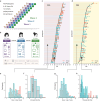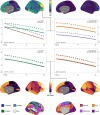A longitudinal resource for population neuroscience of school-age children and adolescents in China
- PMID: 37604823
- PMCID: PMC10442366
- DOI: 10.1038/s41597-023-02377-8
A longitudinal resource for population neuroscience of school-age children and adolescents in China
Abstract
During the past decade, cognitive neuroscience has been calling for population diversity to address the challenge of validity and generalizability, ushering in a new era of population neuroscience. The developing Chinese Color Nest Project (devCCNP, 2013-2022), the first ten-year stage of the lifespan CCNP (2013-2032), is a two-stages project focusing on brain-mind development. The project aims to create and share a large-scale, longitudinal and multimodal dataset of typically developing children and adolescents (ages 6.0-17.9 at enrolment) in the Chinese population. The devCCNP houses not only phenotypes measured by demographic, biophysical, psychological and behavioural, cognitive, affective, and ocular-tracking assessments but also neurotypes measured with magnetic resonance imaging (MRI) of brain morphometry, resting-state function, naturalistic viewing function and diffusion structure. This Data Descriptor introduces the first data release of devCCNP including a total of 864 visits from 479 participants. Herein, we provided details of the experimental design, sampling strategies, and technical validation of the devCCNP resource. We demonstrate and discuss the potential of a multicohort longitudinal design to depict normative brain growth curves from the perspective of developmental population neuroscience. The devCCNP resource is shared as part of the "Chinese Data-sharing Warehouse for In-vivo Imaging Brain" in the Chinese Color Nest Project (CCNP) - Lifespan Brain-Mind Development Data Community ( https://ccnp.scidb.cn ) at the Science Data Bank.
© 2023. Springer Nature Limited.
Conflict of interest statement
The authors declare no competing interests.
Figures





References
-
- Yuste, R. & Bargmann, C. Toward a Global BRAIN Initiative. Cell168, 956–959 (2017). - PubMed
Publication types
MeSH terms
Grants and funding
LinkOut - more resources
Full Text Sources
Molecular Biology Databases
Miscellaneous

